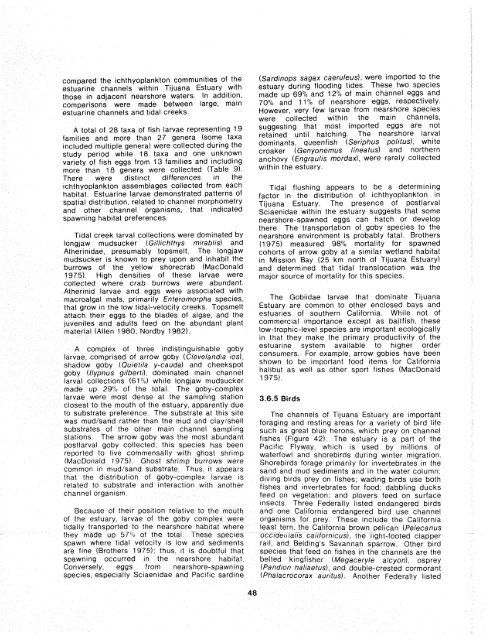The Ecology of Tijuana Estuary, California: An Estuarine Profile
The Ecology of Tijuana Estuary, California: An Estuarine Profile
The Ecology of Tijuana Estuary, California: An Estuarine Profile
You also want an ePaper? Increase the reach of your titles
YUMPU automatically turns print PDFs into web optimized ePapers that Google loves.
compared the ,chthyoplankton communities <strong>of</strong> the (Sardrnops sagax caeruleus), were imported to the<br />
estuarine channels within <strong>Tijuana</strong> <strong>Estuary</strong> with estuary during flooding tides. <strong>The</strong>se two species<br />
those in adjacent nearshore waters. In addition, made up 6g0/o and 12% <strong>of</strong> main channel eggs and<br />
comparisons were made between large, main 70% and 11% <strong>of</strong> nearshore eggs, respectively.<br />
estuarine channels and tidal creeks.<br />
However, very few larvae from nearshore species<br />
were collected within the main channels,<br />
A total <strong>of</strong> 28 taxa <strong>of</strong> fish larvae representing 19<br />
families and more than 27 genera (some taxa<br />
suggesting that imported eggs are<br />
retained unt~l hatching. <strong>The</strong> nearshore larval<br />
multiple genera) were collected during the dominants, weenfish (Seriphus P ~ white ~ ~ ~<br />
period while ,8 taxa and one unknown croaker (Genyonemus lineatus) and northern<br />
variety <strong>of</strong> fish eggs from 13 families and including anchovy (Engraulis mordax), were rarely<br />
more than 18 genera were collected (Table 9). within the estuary.<br />
<strong>The</strong>re were distinct differences in the<br />
fchthyoplankton assemblages collected from each Tidal flushing appears to be a determining<br />
habitat. <strong>Estuarine</strong> larvae demonstrated patterns <strong>of</strong> factor in the distribution <strong>of</strong> ichthyoplankton in<br />
spatial drstr~bution, related to channel rnorphometry <strong>Tijuana</strong> <strong>Estuary</strong>. <strong>The</strong> presence <strong>of</strong> postlarval<br />
and other channel organisms, that indicated Scraenidae wlthin the estuary suggests that some<br />
spawning habitat preferences.<br />
nearshore-spawned eggs can hatch or develop<br />
there. <strong>The</strong> transportation <strong>of</strong> goby species to the<br />
Tidal creek larval collections were dominated by<br />
longjaw rnudsucker (Gtll~chthys mtrablis)<br />
nearshore environment is probably fatal. Brothers<br />
(1975) measured 98% mortality for spawned<br />
Athsrin~dae, presumably topsmelt. <strong>The</strong> longlaw cohorts <strong>of</strong> arrow goby at a similar wetland habitat<br />
fnudsucker is known to prey upon and inhabit the in Mission Bay (25 km north <strong>of</strong> <strong>Tijuana</strong> <strong>Estuary</strong>)<br />
burrows <strong>of</strong> the yellow shorecrab (MacDonaid and determined that tidal translocation was the<br />
1975) High densitres <strong>of</strong> these larvae were major source <strong>of</strong> mortality for thls species.<br />
cotlected where crab burrows were abundant.<br />
Atherinid larvae and eggs were associated wlth<br />
macroalgal mats, prcmarlly Enteromorpha species. <strong>The</strong> Gobi~dae larvae that dominate <strong>Tijuana</strong><br />
that grow In the low tidal-veloc~ty creeks Topsmelt <strong>Estuary</strong> are Common to other f~~closed bays and<br />
attach their eggs to the blades <strong>of</strong> algae, and the estuaries <strong>of</strong> southern <strong>California</strong> While not <strong>of</strong><br />
juvsnifeii and adl~lts feed on the abundant plant commercial importance except as baitfish, these<br />
nrateriai (Allen 198Q, Pdordby 1982).<br />
low-trophic-level species are important ecoiogicaily<br />
in that they make the primary productivity <strong>of</strong> the<br />
A conjplex <strong>of</strong> tt,fee ~ndislingulshabie goby e"uarlne system available to higher order<br />
larvae, comprised <strong>of</strong> arrow goby (Clevelandta IOS),<br />
arrow gobies have been<br />
shadow goby (Quj@tlja y-caude) and cheekspot ShCYA'n to be Important food items for <strong>California</strong><br />
goby (Ilypnus gtibarii), dorn~nated inaln channel as as Other Wort fishes (MacDOnald<br />
larval cullect~ons (81"6) whrle longjaw rnudsucker 1975)<br />
made up 29% <strong>of</strong> the total. <strong>The</strong> goby-complex<br />
larvae were rnost dense at the sampllng statlon 3-65 Birds<br />
closest t0 the mouth <strong>of</strong> the estuary, apparently due<br />
to substrats preference <strong>The</strong> substrate at this s~te <strong>The</strong> channels <strong>of</strong> <strong>Tijuana</strong> <strong>Estuary</strong> are important<br />
Was mud'sand rather than the mud and cla~/shell forag~ng and resting areas for a variety <strong>of</strong> bird life<br />
siibstrates <strong>of</strong> the other main channel sampling such as great blue herons, which prey on channel<br />
stations he arrow goby was the most abundant fishes (Figure 42) <strong>The</strong> estuary IS a part <strong>of</strong> the<br />
~ostfarvaf QobY cail@cted, this species has been Paclflc Flyway, which ,s used by rnilllons <strong>of</strong><br />
ta live contfnensalIy with ghost shrimp waterfowl and shoreblrcfs during winter migration.<br />
(bf,lacDorta'd 'r975), Ghost burrows were Shorebirds forage primarily for invertebrates in the<br />
comman IcT mud/ssnd stJbstrat@ ~~s~ appears sand and mud sediments and In the water column,<br />
that the dlstrlbutlon <strong>of</strong> gob~-cornpl@x k3rvae 1s dlvlng birds prey on fishes, wading birds use both<br />
related substrate and lnte~actlon with another<br />
fishes and invertebrates for food, dabbling ducks<br />
channel organlsrn<br />
feed on vegetation; and plovers feed on surface<br />
~nsects Three Federally listed endangered birds<br />
Because <strong>of</strong> thetr positlon relative to the mouth and one Callfornia endangered bird use channel<br />
<strong>of</strong> the estuary, larvae <strong>of</strong> the goby complex were organtsms for prey <strong>The</strong>se inciude the <strong>California</strong><br />
tidally transported to the nearshore habitat where least tern, the <strong>California</strong> brown pelican (Pelecanus<br />
they made up 57"0 ot the totai <strong>The</strong>se species oc~de,riaiis cai~iorntcusj, the l~ght-footed clapper<br />
spawn where t~dai velocity 1s low and sediments rail, and Belding's Savannah sparrow. Other b~rd<br />
are fine (Brothers 1975): thus, it IS doubtfui that species that feed on fishes In the channels are the<br />
spawning occurred In the nearshore habrtat belted kingfisher (Megaceryle a/cyon), osprey<br />
Conversely, eggs from nearshore-spawning (Pandion haliaetus), and double-crested cormoran!<br />
species, especially Sclaenrdae and Paclfic sardine (Phalacrocorax auntus). <strong>An</strong>other Federally ilsted<br />
48

















